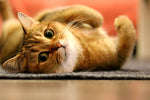 tips
tips
Dehydration in Cats: Is Your Cat Drinking Enough Water?
Cat dehydration can be hard to spot and dangerous. So how do you know if your cat is dehydrated?
Let’s first talk about what dehydration really means.
What Does it Mean for a Cat to be Dehydrated?
As a cat parent, it’s important to keep an eye on your cat’s water intake. If you either notice a decrease in water intake or if your cat has recently suffered from vomiting, diarrhea, drooling or heatstroke, look for dehydration symptoms or take your cat to the vet for tests immediately.
dehydration symptoms or take your cat to the vet for tests immediately.
Stress and some illnesses can also play a role in cat dehydration. Dehydration occurs when your cat isn’t getting enough water or is losing fluids for some reason. This can lead to an imbalance in electrolytes. You may think your cat can’t be dehydrated if you have a readily available water source out for him or her, but that’s not true.
A dehydrated cat won’t necessarily appear thirsty or seek out water. In fact, most cats don’t feel the symptoms of dehydration until the problem becomes serious.
How to Tell if Your Cat is Dehydrated
Skin Elasticity
Gently pull up on the skin between your cat’s shoulder blades and see how long it takes to return to normal. In a well-hydrated cat, the skin should return to normal quickly.
Dry Gums 
Pull back your cat’s cheeks and give them a gentle touch. They should feel wet. If they feel sticky, your cat is probably dehydrated.
Sunken Eyes
Check to see if your cat has dull, unfocused, or sunken eyes.
Dehydrated Coat
Feel your cat’s coat and skin. Is it dry or flaky? If so, she may be dehydrated.
How to Prevent Cat Dehydration
Implementing a few simple changes at home can go a long way toward keeping your cat hydrated and feeling their best.
-
Make sure fresh water is always available.
It may help to have multiple water bowls out around the house and to make sure the bowls aren’t located near scary objects, such as washing machines or vacuum cleaners. -
Get a fountain for your cat.
Cats prefer running water, and there are a variety of products available that provide your pet with a moving stream of water. -
Switch to wet food instead of dry.
Cats generally don’t drink enough on their own and can get much of their daily water from wet food.
If you notice an obvious change in your cat’s drinking habits, or if their symptoms persist after making the above changes you should immediately schedule a visit to the vet to determine the severity and to devise a treatment plan. With dehydration, time is of the essence, so be sure to get a possibly dehydrated cat medical care as soon as possible.
At KOHA, we make cat food with up to 80% moisture to help keep our furry friends hydrated and happy. Our minimal-ingredient meals not only deliver essential hydration, but they also taste great and are chock full of the essential proteins your cat needs to thrive. Find the perfect formula for your feline.

